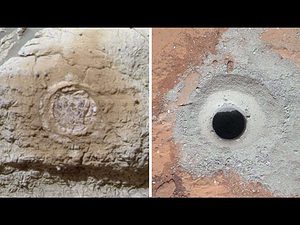I just finished watching NASA‘s latest and definitely most important Curiosity briefing to date. There the Curiosity team announced findings nothing short of spectacular: a slew of chemical elements, minerals and other chemicals have been found in the rover’s first drilled rock sample on Mars, hinting that, at least in the vicinity of the sample site, living microbes might have lived during ancient Mars.

Considering the rover is only in its preliminary phase of its 18 months long mission and the findings come from the first ever drilled sample, the NASA scientists have hit a definite hole in a one.
Sulfur, nitrogen, hydrogen, oxygen, phosphorus and carbon – all key ingredients of life have been identified in the drilled sedimentary rock near an ancient stream bed in Gale Crater on the Red Planet. Moreover, the rock consists in a large proportion of fine-grained mudstone containing clay minerals, sulfate minerals and other chemicals, suggesting that the Yellowknife Bay area the rover is exploring was the end of an ancient river system or an intermittently wet lake bed.
“A fundamental question for this mission is whether Mars could have supported a habitable environment,” said Michael Meyer, lead scientist for NASA’s Mars Exploration Program at the agency’s headquarters in Washington. “From what we know now, the answer is yes.”
Although the findings are still preliminary, during the briefing the Curiosity mission lead scientists reported that this ancient wet environment was not harshly oxidizing, acidic or extremely salty – a fundamental statement, since it suggests that a body of freshwater was once present near the Gale crater region, unlike other environments on Mars.
“Clay minerals make up at least 20 percent of the composition of this sample,” said David Blake, principal investigator for the CheMin instrument at NASA’s Ames Research Center in Moffett Field, Calif.
Life on Mars… once upon a time
Again, the clay minerals serve as a positive indicator of the former presence of water, since it’s the reaction product between freshwater and an igneous mineral, like olivine. The presence of calcium sulfate along with the clay suggests the soil is neutral or mildly alkaline. What’s maybe the most groundbreaking find resulting from the drilled rock is the presence of a mixture of oxidized, less-oxidized and even non-oxidized chemicals. Together they act like a sort of battery providing an energy gradient typically required by microbial life on Earth to exploit to live.
“The range of chemical ingredients we have identified in the sample is impressive, and it suggests pairings such as sulfates and sulfides that indicate a possible chemical energy source for micro-organisms,” said Paul Mahaffy, principal investigator of the SAM suite of instruments at NASA’s Goddard Space Flight Center in Greenbelt, Md.
The analysis was performed by Curiosity’s Sample Analysis at Mars (SAM) and Chemistry and Mineralogy (CheMin) instruments.
“We have characterized a very ancient, but strangely new ‘gray Mars’ where conditions once were favorable for life,” said John Grotzinger, Mars Science Laboratory project scientist at the California Institute of Technology in Pasadena, Calif. “Curiosity is on a mission of discovery and exploration, and as a team we feel there are many more exciting discoveries ahead of us in the months and years to come.”
What’s really interesting, however, aside from the possibility that Mars was indeed once host to life is that the conditions are highly reminiscent of those found on Earth. What this also means is that reversing conditions today through terraforming becomes a more and more viable idea.
For now, however, Curiosity is scheduled to stay around the Yellowknife Bay area for a few more weeks before heading for the Gale Crater’s central mound, Mount Sharp. Here stacks filled with layers of clay, sulfate and other types of minerals have been identified from orbit, and an inspection from up close may serve valuable information as to the duration and diversity of habitable conditions.
We’ll keep you posted with more findings as they surface.


